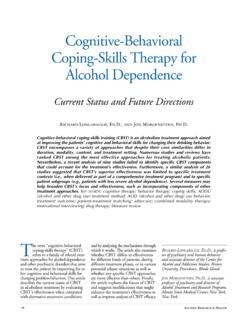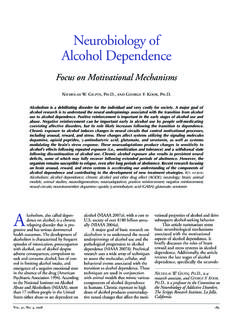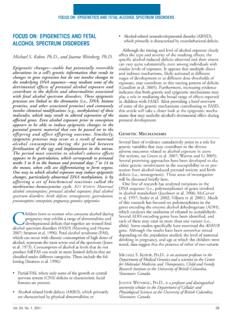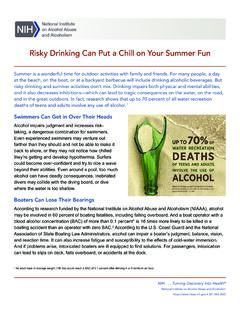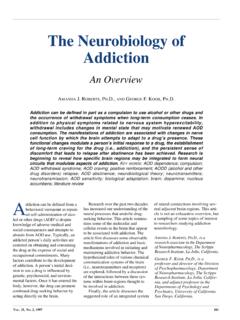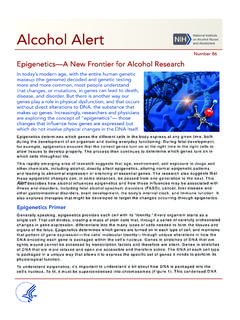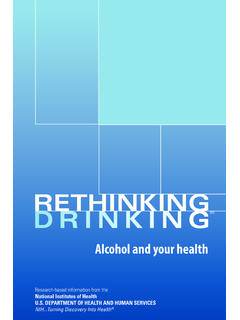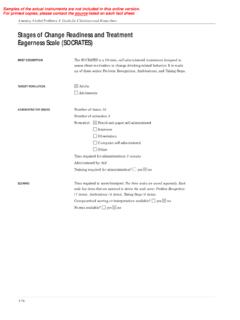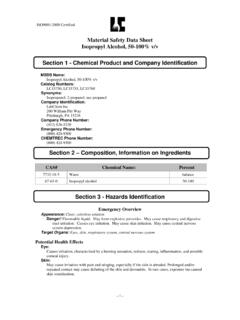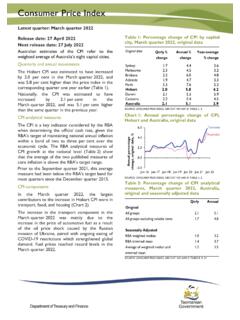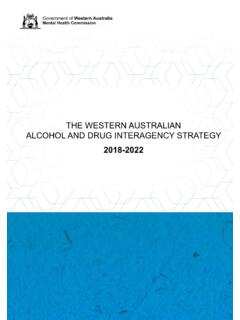Transcription of American Indians and Alcohol - National Institutes of Health
1 SPOTLIGHT ON SPECIAL POPULATIONS. American Indians tribal or language groups. Thus, although some generalities can be drawn with respect to Alcohol use and its related and Alcohol consequences in this population, the variability among tribes and communities should not be disregarded. Alaska Natives are a diverse group themselves and have a somewhat different Fred Beauvais, history and relationship to the Government than do other American Indians . Nonetheless, many similarities exist between The high prevalence of Alcohol use and its consequences them and the native people of the lower 48 States with among American Indians may be attributed to a number respect to Alcohol use and abuse.
2 Therefore, as a matter of of factors, including the influence of the European convention, in this article the ethnic category American colonists who first made large amounts of Alcohol avail- Indian also includes the indigenous people of Alaska. (For able to Indians , as well as current social and cultural more information on Alcohol use among Alaska Natives, see factors. Efforts to prevent and treat Alcohol problems the sidebar by Segal, pp. 276 280.). among the American Indian population may be more effective if native beliefs and approaches are incorporated. Historical Context Alcohol problems also may be prevented through poli- cies regulating the sale and use of Alcohol in Indian com- Before European colonization, the native population of the munities.
3 KEY WORDS: Native American ; Native Alaskan; territory that would eventually become the United States prevalence; AOD use pattern; AOD associated conse- was relatively na ve to Alcohol 's effects. Some tribes produced quences; history of AOD use; culturally sensitive pre- weak beers or other fermented beverages, but these were vention approach; AOD sales; comorbidity; AODD (alco- generally used only for ceremonial purposes. The distillation hol and other drug dependence); behavioral and Health of more potent and thus more abusable forms of Alcohol was disorder; causes of AODU ( Alcohol and other drug use); unknown.
4 When various European colonists suddenly attitude toward AOD; expectancy; acculturation; socio- made large amounts of distilled spirits and wine available to American Indians , the tribes had little time to develop cultural assimilation; treatment; public policy on AOD; social, legal, or moral guidelines to regulate Alcohol use. Early federal government; literature review traders quickly established a demand for Alcohol by introducing it as a medium of trade, often using it in exchange for highly sought-after animal skins and other resources. Traders also A. lcohol abuse and alcoholism have caused compounded found that providing free Alcohol during trading sessions problems for American Indian and Alaska Native gave them a distinct advantage in their negotiations.
5 Peoples. In addition to the enormous physical and Extreme intoxication was common among the colonists emotional tolls, the problems also have led to an unfortunate and provided a powerful model for the social use of Alcohol stereotype that has further burdened the Native communities among the inexperienced Indian populations. Numerous of North America. This stereotype has perpetuated the image historical accounts describe extremely violent bouts of drink- that all Indian people are afflicted with Alcohol problems;. ing among Indian tribes during trading sessions and on other even scientific inquiry, with its emphasis on problem definition, occasions, but at least as many accounts exist of similar behav- has not focused on the vast number of Indian people who ior among the colonizing traders, military personnel, and maintain sober and productive lives (Beauvais in press).
6 Civilians (Smart and Ogborne 1996). Such modeling was Furthermore, most studies of drinking among American not limited to the early colonial era but continued as the land Indians have focused on Indians living on reservations or on was colonized from East to West; trappers, miners, soldiers, and traditional Indian lands, even though this group accounts for lumbermen were well known for their heavy drinking sprees. only one-third of the American Indian population in the History may have therefore sown the seeds for the prevalence United States. With these caveats in mind, the following of Alcohol abuse in North American indigenous populations.
7 Discussion outlines the historical and current status of Alcohol Early demand , with no regulation and strong encouragement, use and abuse within the American Indian population, factors may have contributed to a tradition of heavy Alcohol use proposed to explain American Indian drinking and related passed down from generation to generation, which has led problems, prevention and treatment approaches used in this to the current high level of Alcohol -related problems. community, and the role of Alcohol policies in regulating American Indian drinking. The nearly 2 million American Indians and Alaska Natives living in the United States fall into approximately 300 different Contemporary Patterns of Alcohol Use The level of Alcohol use among American Indian adults is FRED BEAUVAIS, , is senior research scientist at the Tri- difficult to estimate.
8 Drinking practices vary greatly from tribe Ethnic Center for Prevention Research at Colorado State to tribe as a result of cultural, economic, and lifestyle differ- University, Fort Collins, Colorado. ences. Levy and Kunitz (1971) attributed the variability Vol. 22, No. 4, 1998 253. SPOTLIGHT ON SPECIAL POPULATIONS. between tribes to differences in their tolerance of deviant reservations (Beauvais 1992), youth who attend boarding behavior, which in turn lead to different levels of acceptable schools (Dick et al. 1993), and school dropouts (Beauvais drinking. Other analysts have attributed the various rates to et al.)
9 1996). different socioeconomic conditions of reservations (Liban and Among both Indian and non-Indian adolescents, drug Smart 1982; Silk-Walker et al. 1988; Austin et al. 1993). May and Alcohol use are much more tightly coupled than they (1996) reviewed the eight available studies on the prevalence are among adults. Nearly all adolescent drug users also use of drinking among American Indian adults and found vari- Alcohol , and more than one-half of adolescent Alcohol users ation in the proportion of current drinkers 1 from a low of use drugs at some level. It is likely that adolescent drug use 30 percent to a high of 84 percent; the rate among the general and adolescent Alcohol use have many of the same causes non-Indian population was 67 percent (May 1996).
10 Hisnanick and consequences. Data from school surveys generally indi- (1992) estimated the prevalence of Alcohol abuse and alco- cate that drug use is higher among Indian youth compared holism among American Indians using the number of patients with non-Indian youth for nearly all drugs and that mari- discharged with an Alcohol -related diagnosis from Indian juana use in particular is significantly higher among Indian Health Service (IHS) hospitals over an 8-year period. He youth. In 1993, for instance, nearly 50 percent of Indian found that northern reservations gener- students in grades 7 to 12 admitted to ally had much higher rates of such having ever used marijuana (Beauvais diagnoses (the highest rate was 111 per 1996), whereas the rate for non-Indian 1,000 population) than the southern youth of the same age was just 12 per- reservations (the lowest rate was 11 per Alcohol -related cent (Substance Abuse and Mental 1,000).)
